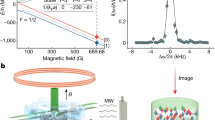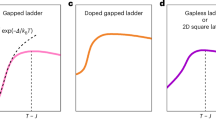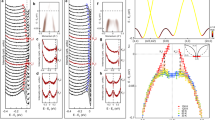Abstract
Cuprates possess a large pseudogap that spans much of their phase diagram1,2. The origin of this pseudogap is as debated as the mechanism for high-temperature superconductivity. In one class of theories, the pseudogap arises from some instability not related to pairing, typically charge, spin or orbital current ordering. Evidence of this has come from a variety of measurements indicating symmetry breaking3,4,5,6. On the other side are theories where the pseudogap is associated with pairing. This ranges from preformed pairs7 to resonating valence bond theories where spin singlets become charge coherent8. Here, we study pairing in the cuprates by constructing the pair vertex using spectral functions derived from angle-resolved photoemission data. Assuming that the pseudogap is not due to pairing, we find that the superconducting instability is strongly suppressed, in stark contrast to what is actually observed. We trace this suppression to the destruction of the BCS logarithmic singularity from a combination of the pseudogap and lifetime broadening. Our findings strongly support those theories of the cuprates where the pseudogap is instead due to pairing.
This is a preview of subscription content, access via your institution
Access options
Subscribe to this journal
Receive 12 print issues and online access
$259.00 per year
only $21.58 per issue
Buy this article
- Purchase on SpringerLink
- Instant access to full article PDF
Prices may be subject to local taxes which are calculated during checkout




Similar content being viewed by others
References
Timusk, T. & Statt, B. The pseudogap in high-temperature superconductors: an experimental survey. Rep. Prog. Phys. 62, 61–122 (1999).
Norman, M. R., Pines, D. & Kallin, C. The pseudogap: Friend or foe of high T c?. Adv. Phys. 54, 715–733 (2005).
Kaminski, A. et al. Spontaneous breaking of time reversal symmetry in the pseudogap state of a high-T c superconductor. Nature 416, 610–613 (2002).
Fauqué, B. et al. Magnetic order in the pseudogap phase of high-T c superconductors. Phys. Rev. Lett. 96, 197001 (2006).
Xia, J. et al. Polar Kerr-effect measurements of the high-temperature YBa2Cu3O6+x superconductor: Evidence for broken symmetry near the pseudogap temperature. Phys. Rev. Lett. 100, 127002 (2008).
Shekhter, A. et al. Bounding the pseudogap with a line of phase transitions in YBa2Cu3O6+δ . Nature 498, 75–77 (2013).
Emery, V. J. & Kivelson, S. A. Importance of phase fluctuations in superconductors with small superfluid density. Nature 374, 434–437 (1995).
Lee, P. A., Nagaosa, N. & Wen, X-G. Doping a Mott insulator: Physics of high-temperature superconductivity. Rev. Mod. Phys. 78, 17–85 (2006).
Chatterjee, U. et al. Dynamic spin-response function of the high-temperature Bi2Sr2CaCu2O8+δ superconductor from angle-resolved photoemission spectra. Phys. Rev. B 75, 172504 (2007).
Kaminski, A. et al. Renormalization of spectral line shape and dispersion below T c in Bi2Sr2CaCu2O8+δ . Phys. Rev. Lett. 86, 1070–1073 (2001).
Stock, C. et al. Spin dynamics near the critical doping in weakly superconducting underdoped YBa2Cu3O635 (T c=18 K). Phys. Rev. B 77, 104513 (2008).
Hinkov, V. et al. Spin dynamics in the pseudogap state of a high-temperature superconductor. Nature Phys. 3, 780–785 (2007).
Monthoux, P. & Pines, D. Spin-fluctuation-induced superconductivity in the copper oxides: A strong coupling calculation. Phys. Rev. Lett. 69, 961–964 (1992).
Scalapino, D. J. A common thread: The pairing interaction for unconventional superconductors. Rev. Mod. Phys. 84, 1383–1417 (2012).
Vilk, Y. M. & Tremblay, A-M. S. Non-perturbative many-body approach to the Hubbard model and single-particle pseudogap. J. Phys. I 7, 1309–1368 (1997).
Dahm, T. et al. Strength of the spin-fluctuation-mediated pairing interaction in a high-temperature superconductor. Nature Phys. 5, 217–221 (2009).
Maier, T. A., Jarrell, M. & Scalapino, D. J. Pairing interaction in the two-dimensional Hubbard model studied with a dynamic cluster quantum Monte Carlo approximation. Phys. Rev. B 74, 094513 (2006).
Norman, M. R., Kanigel, A., Randeria, M., Chatterjee, U. & Campuzano, J. C. Modeling the Fermi arc in underdoped cuprates. Phys. Rev. B 76, 174501 (2007).
in Abramowitz, M. & Stegun, I. A. (eds) in Handbook of Mathematical Functions 806 (Washington, US Govt Print Office, 1964) Eq. 23.1.30
Abrikosov, A. A. & Gorkov, L. P. Contribution to the theory of superconducting alloys with paramagnetic impurities. Sov. Phys. JETP 12, 1243–1253 (1961).
Millis, A. J. Nearly antiferromagnetic Fermi liquids: An analytic Eliashberg approach. Phys. Rev. B 45, 13047–13054 (1992).
Abanov, A., Chubukov, A. V. & Schmalian, J. Quantum-critical theory of the spin-fermion model and its application to cuprates: Normal state analysis. Adv. Phys. 52, 119–218 (2003).
Yang, K-Y., Rice, T. M. & Zhang, F-C. Phenomenological theory of the pseudogap state. Phys. Rev. B 73, 174501 (2006).
Kanigel, A. et al. Evidence for pairing above the transition temperature of cuprate superconductors from the electronic dispersion in the pseudogap phase. Phys. Rev. Lett. 101, 137002 (2008).
Yang, H-B. et al. Emergence of preformed Cooper pairs from the doped Mott insulating state in Bi2Sr2CaCu2O8+δ . Nature 456, 77–80 (2008).
Kohsaka, Y. et al. How Cooper pairs vanish approaching the Mott insulator in Bi2Sr2CaCu2O8+δ . Nature 454, 1072–1078 (2008).
Alldredge, J. W. et al. Evolution of the electronic excitation spectrum with strongly diminishing hole density in superconducting Bi2Sr2CaCu2O8+δ . Nature Phys. 4, 319–326 (2008).
Acknowledgements
The authors thank D. Scalapino for suggesting this work, and he and A. Chubukov for several helpful discussions. Work at Argonne was supported by the Centre for Emergent Superconductivity, an Energy Frontier Research Centre funded by the US DOE, Basic Energy Sciences, under Award No. DE-AC0298CH1088.
Author information
Authors and Affiliations
Contributions
V.M. and M.R.N. conceived the project, carried out the work, and wrote the paper. U.C. and J.C.C. provided the data as well as ideas for the data analysis.
Corresponding author
Ethics declarations
Competing interests
The authors declare no competing financial interests.
Supplementary information
Supplementary Information
Supplementary Information (PDF 407 kb)
Rights and permissions
About this article
Cite this article
Mishra, V., Chatterjee, U., Campuzano, J. et al. Effect of the pseudogap on the transition temperature in the cuprates and implications for its origin. Nature Phys 10, 357–360 (2014). https://doi.org/10.1038/nphys2926
Received:
Accepted:
Published:
Issue date:
DOI: https://doi.org/10.1038/nphys2926
This article is cited by
-
Coupled electronic and magnetic excitations in the cuprates and their role in the superconducting transition
Communications Physics (2022)
-
Fluctuation induced conductivity and pseudogap state studies of Bi1.6Pb0.4Sr2Ca2Cu3O10+δ superconductor added with ZnO nanoparticles
Scientific Reports (2021)
-
Peculiarities of pseudogap in Y0.95Pr0.05Ba2Cu3O7−δ single crystals under pressure up to 1.7 GPa
Scientific Reports (2019)
-
Effect of annealing on a pseudogap state in untwinned YBa2Cu3O7−δ single crystals
Scientific Reports (2019)
-
Revisiting the vortex-core tunnelling spectroscopy in YBa2Cu3O7−δ
Nature Communications (2016)



